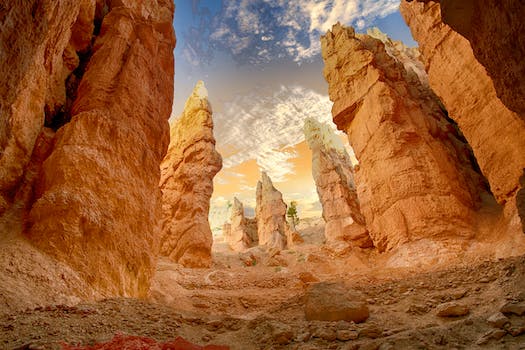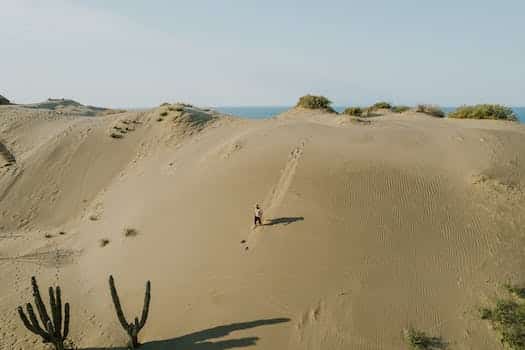Wilderness camping in the desert can be a truly breathtaking experience. The vast expanse of sand and sky, the stunning sunsets and starry nights, and the unique flora and fauna all combine to create a sense of awe and wonder. Whether you’re a seasoned camper or a first-timer, there’s something about the desert that draws us in and inspires us to explore. In this article, we’ll take a closer look at the wonders of wilderness camping in the desert and offer tips and advice for making the most of your adventure.
- 1. Preparing for Your Wilderness Camping Trip
- 1.1. Choosing the Right Equipment
- 1.2. Packing Your Gear Efficiently
- 1.3. Planning Your Meals
- 1.4. Staying Safe and Hydrated
- 1.5. Navigating the Desert Terrain
- 2. Finding the Perfect Campsite
- 2.1. Researching Potential Locations
- 2.2. Scouting for Water Sources
- 2.3. Assessing the Terrain
- 2.4. Avoiding Wildlife
- 2.5. Setting Up Your Campsite
- 3. Making the Most of Your Desert Camping Experience
1. Preparing for Your Wilderness Camping Trip
Before embarking on a wilderness camping trip in the desert, it is important to properly prepare. This includes packing all necessary equipment such as a tent, sleeping bag, and camping stove. It is also important to research the area you will be camping in and familiarize yourself with the terrain and weather patterns. Make sure to bring plenty of water and food, as well as a first aid kit in case of emergencies. Additionally, it is crucial to leave no trace and practice responsible camping techniques to minimize impact on the environment.
1.1. Choosing the Right Equipment
When preparing for a wilderness camping trip in the desert, it is important to choose the right equipment. One of the most important pieces of equipment is a reliable tent. Look for a tent that is made of durable materials that can withstand the harsh desert conditions. It should also be easy to set up and take down, as you may need to move quickly in case of a sudden sandstorm or other unexpected weather.
Another crucial piece of equipment is a high-quality sleeping bag. Desert nights can be surprisingly cold, so you’ll want a bag that is rated for at least 10 degrees Fahrenheit below the lowest temperature you expect to encounter. Look for a bag that is lightweight and easy to pack, as you’ll be carrying it with you on your trip.
In addition to a tent and sleeping bag, you’ll also need a reliable backpack to carry your gear. Look for a backpack that is comfortable to wear and has plenty of compartments for storing all of your camping essentials. You’ll also want to invest in a good pair of hiking boots or shoes, as well as a lightweight, moisture-wicking shirt and pants to keep you cool and dry in the desert heat.
By choosing the right equipment, you’ll be well-prepared for your wilderness camping trip in the desert. With the right gear and a little bit of planning, you can explore the wonders of the desert and experience the thrill of sleeping under the stars in one of the most beautiful and rugged landscapes on earth.
1.2. Packing Your Gear Efficiently
Packing your gear efficiently is a crucial part of preparing for your wilderness camping trip in the desert. With limited space and weight restrictions, it’s important to prioritize the items you’ll need most and pack them in a way that maximizes space. Start by making a list of essential items, such as a tent, sleeping bag, cooking equipment, and plenty of water. Then, think about the order in which you’ll need to access these items and pack them accordingly. Use compression sacks and stuff sacks to condense bulky items like sleeping bags and clothing, and organize smaller items in plastic bags or pouches. Finally, be sure to distribute the weight evenly in your backpack and use straps or bungee cords to secure any loose items. By packing your gear efficiently, you’ll be able to enjoy your wilderness camping trip without feeling weighed down by heavy or unnecessary items.
1.3. Planning Your Meals
Planning your meals is an important aspect of preparing for a wilderness camping trip, especially in the desert. The harsh climate can make it difficult to carry perishable foods, so it’s important to plan ahead and choose non-perishable items that will sustain you for the duration of your trip. Consider packing items such as dehydrated or freeze-dried meals, nuts, seeds, and dried fruits. These foods are lightweight, compact, and easy to prepare with just a little bit of water. Be sure to also pack plenty of water and electrolyte drinks to keep you hydrated in the heat. By planning your meals ahead of time, you can ensure that you have enough nourishing food to keep you energized for all of your desert adventures.
1.4. Staying Safe and Hydrated
Staying safe and hydrated is essential when preparing for your wilderness camping trip in the desert. The arid climate can quickly dehydrate you, so it’s crucial to bring plenty of water and electrolyte-replacement drinks. It’s also important to protect yourself from the sun by wearing a hat, sunglasses, and sunscreen with at least SPF 30. Be aware of the signs of heat exhaustion and heat stroke, such as dizziness, nausea, and confusion, and take immediate action if you or someone in your group experiences them. Additionally, always let someone know where you’re going and when you plan to return, and bring a fully charged cell phone or other communication device in case of emergency.
2. Finding the Perfect Campsite
When it comes to wilderness camping in the desert, finding the perfect campsite is crucial. Start by researching the area you plan to visit and identify any designated camping areas or campgrounds. These areas often have amenities such as fire pits and toilets, but may require reservations. If you prefer a more secluded experience, look for dispersed camping options where you can set up camp anywhere that is not prohibited. Be sure to check regulations and obtain any necessary permits before heading out. Consider factors such as shade, water sources, and proximity to hiking trails when selecting a campsite. And don’t forget to leave no trace and pack out all trash to help preserve the beauty of the desert for future generations to enjoy.
2.1. Researching Potential Locations
When it comes to planning a camping trip in the desert, choosing the right location is key. Researching potential campsites beforehand can help ensure a successful and enjoyable trip. Factors to consider when researching potential locations include the availability of water, the presence of wildlife, and the accessibility of the site. By taking the time to do your research, you can find the perfect campsite for your needs and make the most out of your wilderness camping experience.
2.2. Scouting for Water Sources
One of the most important aspects of wilderness camping in the desert is scouting for water sources. Before setting up camp, it’s crucial to identify nearby sources of water, whether it be a natural spring, creek, or well. Without access to water, a camping trip can quickly turn into a dangerous situation. It’s also important to have a plan for water storage and filtration, as many water sources in the desert may contain harmful bacteria or minerals. By taking the time to scout for and properly prepare water sources, campers can ensure a safe and enjoyable trip in the wilderness.
2.3. Assessing the Terrain
Assessing the terrain is crucial when searching for the perfect campsite in the desert. Look for flat, level ground that is free of rocks and debris. Avoid camping in dry washes or gullies, as flash floods can occur unexpectedly. It’s also important to consider the proximity to water sources and shade, as well as any potential hazards such as cactus or poisonous plants. Take the time to carefully scout out the area before setting up camp to ensure a safe and comfortable experience.
2.4. Avoiding Wildlife
When setting up camp in the desert, it’s important to be mindful of the wildlife that may be present. Here are some tips for avoiding encounters with animals:
– Choose a campsite away from watering holes or other food sources that may attract animals.
– Keep all food and trash securely stored in sealed containers or hung from a tree out of reach.
– Avoid cooking or eating in your tent, as the smell of food can attract animals.
– Make noise when walking around camp to alert any nearby animals of your presence.
– If you do encounter wildlife, keep a safe distance and do not approach or feed them.
By following these guidelines, you can enjoy a safe and peaceful camping experience in the desert wilderness.
2.5. Setting Up Your Campsite
When it comes to wilderness camping in the desert, finding the perfect campsite is just the beginning. Once you have chosen your ideal location, it’s time to set up your campsite. Here are some tips to help you do just that:
1. Clear the area: Before setting up your tent, make sure the ground is clear of rocks, branches, and other debris. This will not only make your sleeping area more comfortable but also help prevent damage to your tent.
2. Choose a flat surface: Look for a spot that is level and free from any slopes or depressions. This will ensure that your tent is stable and won’t tip over during the night.
3. Set up your tent: Follow the manufacturer’s instructions to set up your tent. Make sure it’s secure and properly staked down.
4. Create a fire pit: If you plan to have a campfire, dig a small pit and surround it with rocks to contain the fire.
5. Store your food properly: Keep all food in a secure container or hang it from a tree to prevent animals from getting to it.
By following these simple steps, you can set up a comfortable and safe campsite in the desert wilderness.
3. Making the Most of Your Desert Camping Experience
Camping in the desert can be a unique and rewarding experience, but it’s important to be prepared. One key to making the most of your desert camping trip is to plan ahead and pack the right gear. You’ll need a sturdy tent that can withstand strong winds and protect you from the hot sun during the day and the cold desert nights. You’ll also need plenty of water, as dehydration is a common risk in the desert. In addition to water, pack plenty of high-energy snacks to keep you fueled throughout the day. Don’t forget to bring sunscreen, sunglasses, and a hat to protect your skin and eyes from the intense desert sun. With the right preparation, you can enjoy all the wonders that the desert has to offer while staying safe and comfortable.
3.1. Enjoying the Night Sky
One of the most magical parts of desert camping is the opportunity to enjoy the night sky. With little light pollution, the stars shine bright and the constellations are easy to spot. Set up a comfortable spot to lie down and gaze up at the sky. Bring a star chart or download an app to help you identify what you’re seeing. Don’t forget to make a wish on a shooting star!
3.2. Exploring the Surrounding Area
Exploring the surrounding area is a must-do activity when camping in the desert. Venture out on foot or by vehicle to discover the unique flora and fauna, rock formations, and expansive views. Keep an eye out for desert wildlife such as lizards, snakes, and jackrabbits. Take a hike to a nearby canyon or mountain for breathtaking vistas. Or, go on a guided tour to learn about the history and culture of the area. No matter how you choose to explore, the surrounding desert is sure to leave a lasting impression on you.
3.3. Trying New Outdoor Activities
Trying new outdoor activities is a great way to make the most of your desert camping experience. Whether you’re an experienced outdoorsman or a beginner, there are plenty of activities to try in the desert. You could go hiking, rock climbing, or even try your hand at sandboarding. The possibilities are endless, and the desert is the perfect place to explore them. So get out there and try something new on your next camping trip!
3.4. Relaxing and Unwinding
When camping in the desert, it’s important to take some time to relax and unwind. The desert can be a harsh environment, so it’s crucial to recharge your batteries and take care of yourself. Take a break from hiking or exploring and simply enjoy the peacefulness of the surrounding wilderness. Bring a book, a journal, or some music to help you unwind. You can also practice yoga or meditation to help calm your mind and body. Whatever you choose, make sure you take some time to relax and rejuvenate during your desert camping experience.
3.5. Leaving No Trace
When camping in the desert, it’s important to leave no trace of your presence. This means packing out all of your trash, including food scraps and toilet paper. Digging trenches or fire pits can also leave lasting damage to the fragile desert ecosystem. Instead, use a portable stove for cooking and bring a camp toilet or use established restroom facilities. By leaving no trace, you can help preserve the natural beauty of the desert for future generations to enjoy.
Conclusion
In conclusion, wilderness camping in the desert is an unforgettable experience that offers a unique opportunity to connect with nature and explore the wonders of the great outdoors. From stunning landscapes to fascinating wildlife, camping in the desert is a truly rewarding adventure that should be on every nature lover’s bucket list.





